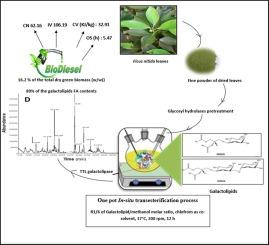通过嗜热塔拉尔酵母菌半乳脂肪酶对膜半乳脂肪的原位生物转化,利用硝化榕叶生产可持续生物柴油
IF 7.5
1区 工程技术
Q2 ENERGY & FUELS
引用次数: 0
摘要
构成光合生物叶绿体膜的半乳糖脂是地球上主要的脂肪酸库。然而,这一丰富的资源完全没有得到开发。由于半乳糖脂分散在植物生物质中,因此无法像植物三酰甘油那样通过简单的物理方法获取。在这里,我们证实了嗜热塔拉酵母脂肪酶(TTL)具有很高的半乳脂肪酶活性,能够水解并完全转化作为非油料绿色原料的干燥榕树叶片中的天然半乳脂,分别生成脂肪酸(FA)和脂肪甲酯(FAME)。通过对整个绿色生物质进行原位酯交换反应,进一步探索了其高半乳脂酶活性。因此,开发出了一种成功的单锅程序系统。在脂质/甲醇摩尔比为 1/6、氯仿为助溶剂、温度为 37 °C、游离 TTL 为 660 U 的条件下,对 750 毫克经糖基水解酶预处理的干燥硝化纤维叶片进行了优化甲醇分解。反应 12 小时后,得到 121 ± 8.2 毫克生物柴油,其中 66% 由 FAME 组成,33% 由烷烃(C16-C24)组成。80 ± 1.14 毫克 FAME(s) 由叶片中的半乳糖脂 FA 转化而来,回收率为 89%。经评估,硝化纤维叶的甲醇提取物是一种抗氧化剂,有助于防止所产生的多不饱和脂肪酸的氧化过程。最后,回收和/或转化绿色生物质中的半乳脂脂肪酸有望成为一种生产分子的方法,有可能在现有的石油精炼厂中进行联合精炼,并避免与植物油争夺利益。本文章由计算机程序翻译,如有差异,请以英文原文为准。

Sustainable biodiesel production from Ficus nitida leaves through the in-situ bioconversion of membrane galactolipids by Talaromyces thermophilus galactolipase
Galactolipids constituting the chloroplast membranes in photosynthetic organisms represent the main reservoir of fatty acids on earth. This abundant resource is, however, completely untapped. Galactolipids are not accessible by simple physical means as vegetable triacylglycerols since they are dispersed in plant biomass. Here, we establish that Talaromyces thermophilus lipase (TTL), with a high galactolipase activity, has the capacity to hydrolyze and fully convert the natural galactolipids of dried Ficus nitida leaves as a non-oilseed green feedstock to produce fatty acids (FA) and fatty methyl esters (FAME), respectively. Its high galactolipase activity was further explored by performing in-situ transesterification reaction on the whole green biomass. Thus, a successful system for one-pot procedure was developed. Optimized methanolysis conditions were obtained with a lipid/methanol molar ratio of 1/6, chloroform as a co-solvent, a temperature of 37 °C and 660 U of free TTL for 750 mg of dried F. nitida leaves pretreated with glycosyl hydrolases. After 12 h of reaction, 121 ± 8.2 mg of biodiesel was obtained, of which 66 % was composed of FAME(s) and 33 % was composed of alkanes (C16-C24). 80 ± 1.14 mg of FAME(s) were converted from galactolipid FA within leaves with a recovery yield of 89 %. The methanolic extract of F. nitida leaves was evaluated as an antioxidant source and could help prevent the oxidation process of the polyunsaturated FAME(s) produced. Lastly, recovering and/or converting galactolipid FA in green biomass shows promise as a way of producing molecules with a potential to co-refine in existing petroleum refineries and to avoid competing interests with vegetable oils.
求助全文
通过发布文献求助,成功后即可免费获取论文全文。
去求助
来源期刊

Fuel
工程技术-工程:化工
CiteScore
12.80
自引率
20.30%
发文量
3506
审稿时长
64 days
期刊介绍:
The exploration of energy sources remains a critical matter of study. For the past nine decades, fuel has consistently held the forefront in primary research efforts within the field of energy science. This area of investigation encompasses a wide range of subjects, with a particular emphasis on emerging concerns like environmental factors and pollution.
 求助内容:
求助内容: 应助结果提醒方式:
应助结果提醒方式:


